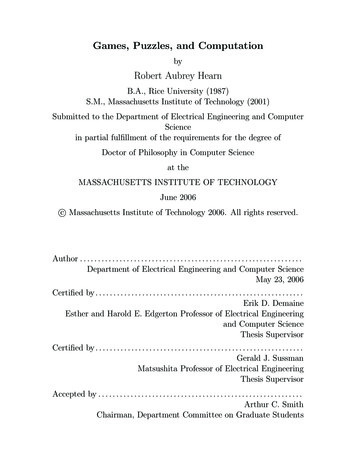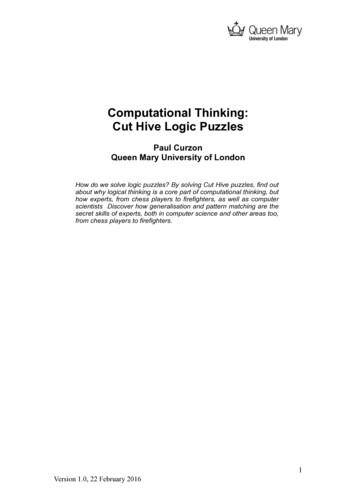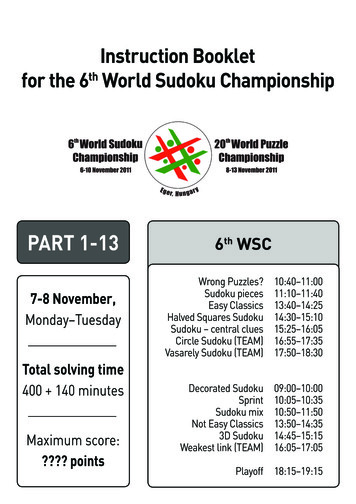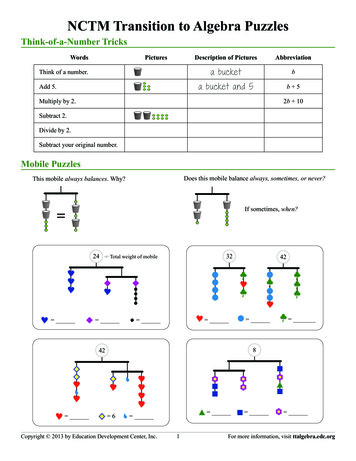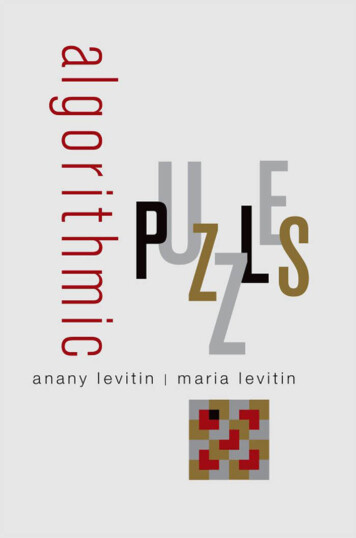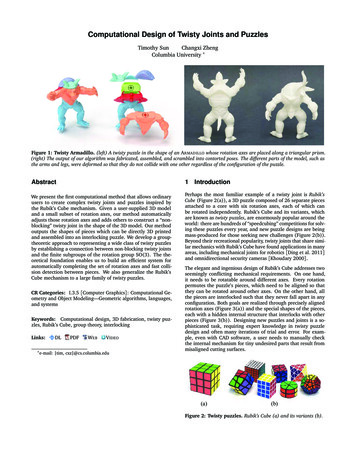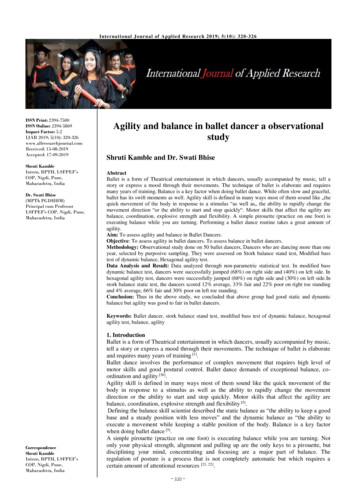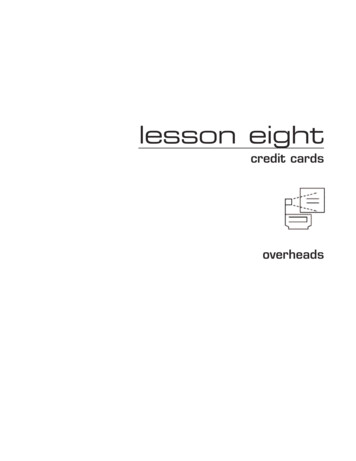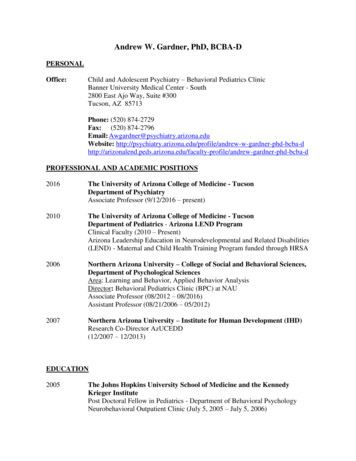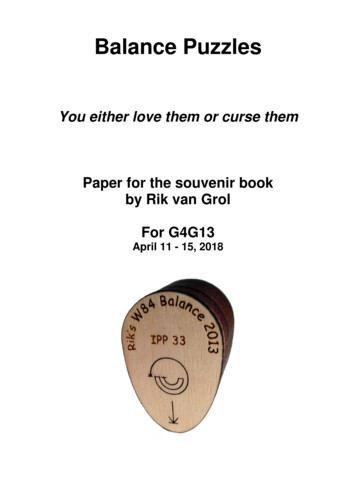
Transcription
Balance PuzzlesYou either love them or curse themPaper for the souvenir bookby Rik van GrolFor G4G13April 11 - 15, 2018
Balance PuzzlesYou either love them or curse themby Rik van Grol, NLRvgrol@hotmail.comA well-known balance puzzle is the Columbus Egg. The object is to balance the egg on its tip.Impossible so it seems! By using other senses than just vision, such as hearing and feeling, and bylogical thinking, some patience and above all perseverance the solution can be found. Carefulmanipulation of the egg centralizes the weight of the egg and then it can be balanced on its tip.Many people lack some of the above mentioned qualities and will never solve these puzzles;consequently they dislike them or even curse them. Some even say that they are not puzzles. Ifthey would experience solving them they would realize that these are indeed puzzles and theywould love them.IntroductionWhat do I mean with a balance puzzle? When you google for the term "balance puzzle" the searchresults do not lead you towards the puzzles I mean. The balance puzzle, or weighing puzzle,google provides is a logic puzzle about balancing items, often coins. Other balance puzzles willalso appear. To find the puzzles I mean you should google for the term "Columbus Egg puzzle".Many of the balance puzzles this paper is about are egg-like objects, but not all of them.So what is a balance puzzle? Best is to take the egg balance puzzle as an example. The object ofthe egg balance puzzle is to put the egg on its tip. With a regular egg this will result in the eggtipping over (not always – see the tale about Columbus), but with the egg balance puzzle there is away to manipulate the egg in such a way that it will indeed stand on its tip.A famous example is the Columbus Egg presented at the World Fair in Chicago in 1893. Thismetallic souvenir egg contains a ball that can be manoeuvred in such a way that it falls down atube and ends up in the tip of the egg on which it can then be stood upright.So, what are typical properties of a balance puzzle? They are single piece puzzles in that they are not meant to be taken apart. The puzzle needs to be manipulated in such a way that something internally is changed inorder for the object to be balanced. Most balance puzzle do not have handles or levers. They can only be manipulated in a 3D-space: e.g. lifted, tilted, rotated, spinned. Most balance puzzles provide no clues as to whether or not you are heading in the rightdirection to solve it. With these puzzles you are, as it were, "left in the dark".These properties, that most balance puzzles have, are exactly the properties that make you eitherlove these puzzles or curse them. To solve a balance puzzle you need to use other senses thanwith most mechanical puzzles. Instead of depending on visual clues you now depend on sound,feeling and your creative ability to crawl into the mind of the designer. Many people, and alsopuzzlers, do not like to be left in the dark. Balance puzzles can be very frustrating, and unlikesecret opening boxes (that share similar properties) they generally lack a satisfying AHA feeling.Personally I am in-between love and hate. I hate balance puzzles until I have solved them, then Ilove them.In this paper I will start with some anecdotal history about egg balance puzzles. This will befollowed by an overview of balance puzzles. Then I will talk about the different types ofmechanisms used in balance puzzles, and how to solve them.Afterwards you can decide for yourself whether to like or to curse them.
Anecdotal historyThe oldest egg balance puzzle I know of is the Columbus Egg, see Figure 1. I am sure there musthave been earlier puzzles, but not produced in the quantity as this one. I also do not have anyrecord of other such puzzles from an earlier age. If a reader does, I would be very much interested.The Columbus Egg was presented at the World Fair in Chicago in 1893 as a souvenir. Wikipediasays the following about this event [1]:The World's Columbian Exposition (the official shortened name for the World's Fair:Columbian Exposition also known as the Chicago World's Fair and Chicago ColumbianExposition) was a world's fair held in Chicago in 1893 to celebrate the 400th anniversary ofChristopher Columbus's arrival in the New World in 1492.Wikipedia also mentions an “Egg of Columbus” in relation to the World Fair, but this is not ourpuzzle egg. The mentioned egg is a metal egg that spun inside an electric field. Quite a novelty atthat time I have found no record of our puzzle egg being mentioned in relation to the World Fair,but it must be strongly related to the same celebration as the puzzle depicts Columbus and theperiod 1492-1892. In The Book of Ingenious & Diabolical Puzzles [2] Jerry Slocum mentions theEgg of Columbus as made for the Columbian Exposition. Professor Hoffmann in Puzzles Old andNew [3] also mentions a New Egg of Columbus, but this is not our egg.So, there are quite a few Columbus Eggs. What is it about Columbus and eggs anyway? This hasto do with a tale, and the clue of the tale is related to solving these puzzles. It is a tale from(according to Wikipedia) the historian Girolamo Benzoni, who wrote [4]:Columbus being at a party with many noble Spaniards, where, as was customary, the subjectof conversation was the Indies: one of them undertook to say: "Mr. Christopher, even if youhad not found the Indies, we should not have been devoid of a man who would haveattempted the same that you did, here in our own country of Spain, as it is full of great menclever in cosmography and literature." Columbus said nothing in answer to these words, buthaving desired an egg to be brought to him, he placed it on the table saying: "Gentlemen, Iwill lay a wager with any of you, that you will not make this egg stand up as I will, naked andwithout anything at all." They all tried, and no one succeeded in making it stand up. When theegg came round to the hands of Columbus, by beating it down on the table he fixed it, havingthus crushed a little of one end; wherefore all remained confused, understanding what hewould have said: that after the deed is done, everybody knows how to do it; that they oughtfirst to have sought for the Indies, and not laugh at him who had sought for it first, while theyfor some time had been laughing, and wondered at it as an impossibility.This out-of-the-box-thinking is exactly what is needed for solving many puzzles, especially thesepuzzle eggs. Quite often, maybe even always, egg balance puzzles are categorized underdexterity puzzles. And, yes, they certainly need some dexterity for solving, but by applying logic,deduction, creative thinking it can become much more a puzzle that can be solved at will.Overview of balance puzzlesAn small overview of some balance puzzles is available on the internet, on Rob’s Puzzle pages [5].It starts off with the 1893 Columbus Egg puzzle but also shows several of the others presentedbelow. Partly due to a link on his pages I was led to a number of patents on egg balance puzzles.The U.S. Patent Office devotes an entire sub-class to "Balancing Ovoids" (ccl/273/154). Most ofthe patents are from the time around the World's Columbian Exposition in 1893. Rob’s pages alsodemonstrated that there are several variants of the 1893 Columbus Egg puzzle – some with aninscription: “World's Fair Souvenir”. My copy of Columbus Egg does not show these words.
No. NameDate1Columbus Egg Puzzle18932Fall Guy19513Magic Egg Puzzle?Balance Solution PuzzleDescriptionobjecttype/ trickMetal egg shaped balance puzzle. Internally there is a ramp that will let thelogic &ballpuzzle ball fall into a tube towards the tip. Made by P.M. Baumgardner & Co, USA.pathPuzzle in my possession.This is a small trick in the shape of a man. This is more a magic trick than apuzzle. After holding it upside-down for about 20 seconds you can turn itsandtricktrick around and balance it on its feet. Then after about 15 seconds it will fallover. From Four Guys Products Inc. , New York , USA. Puzzle from the LillyLibrary, Bloomington, IN, USA.balllogic &pathPlastic egg-shaped balance puzzle. Internally there is a ramp that will leadpuzzle the ball to a central resting position, which will allow you to balance the egg.Patent US 1,763,814. Puzzle from the Lilly Library, Bloomington, IN, USA.4Magic Egg?sandtricktrick5The Trick?sandtricktrick6No name?balllogic &pathpuzzle7The X super puzzle1984n.a.twistypuzzle8L’UOVO DI COLOMBO1990'sballtrickpuzzle9Tower of Pisa2000sandlogicpuzzle10Dice2002balllogic &pathpuzzle11Clock2008ball12Rik's Egg Balance 20102010two balls13Rik's Egg Balance 20112011ball14Rik's Egg Balance 20132013sand15Ze Balancing Egg2015balllogicA.k.a. L'Oeuf Enchanté, Trick-ei, "Ei des Columbus". This is an egg-shapedbalance puzzle from Pussy, Germany. This is more a magic trick than apuzzle. After holding it tip-side-up for 20-25 seconds you can turn it aroundand balance it on its tip. Art-Nr. 80 2100. Then after about 10 seconds it willfall over. Puzzle in my possession.This is a trick in the shape of a doll. This is more a magic trick than a puzzle.After holding it upside-down for a while you can turn it over and balance it,head in the air. Then after a while it will fall over. From TOBAR Norfolk UK.Puzzle from James Dalgety.Yellow-red plastic egg-shaped balance puzzle. Internally there is a trenchthat will lead the ball to a central resting position which will allow you tobalance the egg. Origin unknown. Puzzle in my possession.A.k.a. Columbus puzzle(?). This is an egg shaped balance puzzle, but unlikeothers it has two moving parts. The bottom half of the egg can rotate inrelation to the top, and it has a sliding button with three positions. There isalso a small window, behind which there are five disks visible that each cantake ten positions. One of the ten positions shows red through the window.Sequences of rotations and different positions of the button are needed toget all five disks to show their red position. Then a weight is unlocked,which will allow you to balance the egg on its tip. Origin: Japan. Patented byMorichika Hatakeyama and Koichi Minami. Patent US 4,489,944. Puzzle fromthe Lilly Library, Bloomington, IN, USA.Plastic egg-shaped balance puzzle. Internally there is a tube. No ramp oranything else to help. Object is to get the ball into the tube, which requiresdexterity. Patented by Sileno Lavorini, Pat no. 0336/676303. Made in Italy.Puzzle in my possession.This wooden tower of Pisa is a slanted tube. Internally it has cavities withsand. By moving the sand around, balance can be reached. The puzzle alsocontains a ball as decoy. Exchange puzzle from Tatjana Matveeva (Russia) atIPP 20, in 2000, in LA, USA. Puzzle in my possession.This is a die that is to be stood upright on a flattened corner. Internally thereis a ball and a central stem on whch the ball can be positioned to balance thedice. Dexterity is expected, but with the right movement you alwayssucceed. Exchange puzzle from Jacques Zeimet (France) at IPP 22, in 2002, inAntwerp, Belgium. Puzzle in my possession.This is a disc that looks like a clock that is to be stood upright. Internallythere is a ball, and several moving objects (the latter are fixed to theirpuzzle position). The ball must be moved between the objects to a location inorder to balance the puzzle. Exchange puzzle from Jacques Zeimet (France)at IPP 28, in 2008, in Prague, Czech Republic. Puzzle in my possession.2D-egg-shaped balance puzzle. This is a flattened egg made of wood.Internally there is a ramp by which the two balls need to be transported tothe tip, one at a time. Exchange puzzle from Rik van Grol (The Netherlands)at IPP 30, in 2010, in Osaka, Japan. Puzzle in my possession.2D-egg-shaped balance puzzle. This is a flattened egg made of wood.Internally it is mostly empty. The provided stand needs to be used tologic &release the ball such that the ball drops to the tip. Solution is symbolicallypuzzlepathdepicted on the outside of the puzzle. Exchange puzzle from Rik van Grol(The Netherlands) at IPP 31, in 2011, in Berlin, Germany. Puzzle in mypossession.2D-egg shaped balance puzzle. This is a flattened egg made of wood.Internally there are several chambers, partially filled with sand. The sandlogic &must be manipulated such that it is transported to the tip. Solution ispuzzlepathsymbolically depicted on the outside of the puzzle. Exchange puzzle fromRik van Grol (The Netherlands) at IPP 33, in 2013, in Narita, Japan. Puzzle inmy possession.Wooden egg-shaped balance puzzle. Traditional balance puzzle, but with alogic &puzzle very subtle ramp. Exchange puzzle from Stephen Chin (Australia) at IPP 35,dexterityin 2015, in Ottawa, Canada. Puzzle in my possession.logic &pathpuzzle
1. Columbus Egg Puzzle5. The Trick9. Tower of Pisa12. Rik’s Egg Balance 20102. Fall Guy6. (no name available)10. Dice13. Rik’s Egg Balance 20103. Magic Egg Puzzle7. The X super puzzle4. Magic Egg8. L’UOVO DI COLOMBO11. Clock14. Rik’s Egg Balance 201015. Ze Balancing Egg
Mechanisms of balance puzzlesThe mechanisms of balance puzzles and their solution type are closely related. In the table abovedifferent solution types are listed. The solution types relate directly to the method used to transferthe moving weight to a position where balance can be achieved. This is generally done by centralizing the weight. The solution types listed are: Path With path I mean that there is a distinct place or position to start (to position theweight) and then there is a specific path or movement to make, after which the weight iscentralized and the egg can be balanced. Trick The eggs classified as trick are not puzzles that you can solve. They are moreattributes of a magician. A magician will make you believe the “puzzle” can be solved (theegg can be stood upright), but this is an illusion. The object seems to balance indefinitely,but in reality it does so for only a short period of say ten seconds or so. Before the balanceis lost, the magician will pick up the egg and hand it to the audience. The audience will tryand fail. The trick-eggs, in my view, do not actually belong in this list as they are notpuzzles, but I keep them in to show the contrast with real balance puzzles. Twisty this relates to the fact that the puzzle itself can be altered, by twisting or shifting.Most balance puzzles have moving parts, but only internally and they cannot be controlleddirectly. With twisty puzzles you do have direct control, turning, shifting or otherwise alteringthe puzzle. Logic A balance puzzle generally leaves you in the dark as to what can or needs to bedone, but observation (feeling and hearing) combined with creativity and logic may and/orwill help you find a solution. Logic is generally combined with path or dexterity. Dexterity with dexterity the manipulation of the object the egg is meant: tilting,shifting, flipping, etc. When a puzzle has a high level of dexterity, it may take a lot ofpractise.Most balance puzzle are characterized by combinations of the above.Relating dexterity a further deliberation is required. Almost every puzzle requires a level ofdexterity. Personally I would classify a puzzle as a dexterity puzzle if you fail more often than yousucceed and if you cannot use logic to turn the odds.Solving balance puzzlesSolving a balance puzzle starts by investigating the puzzle. When you solve any puzzle you startby making some observations. In the case of balance puzzles your eyes are not given a lot ofclues, so you need to rely on your other senses, mostly hearing and feeling, as smelling andtasting generally do not really help with puzzles.At this stage the object is to determine the type of balance puzzle. Based on the suspectedmechanism, or combinations of mechanisms, you start looking for further clues. If it is a well-knownmechanism the task may be relatively straightforward, but if it is new then the problem is muchmore difficult. You need to imagine a new mechanism and “look” for clues. Looking in this contextis, again, mostly feeling and hearing. This is the part that can be really satisfying or extremelyfrustrating. Satisfying if your suspicion was right and you find the path or logic and solve thepuzzle. Frustrating if you cannot find the path, cannot imagine the new mechanism, cannot explainwhat is happening.At this point two other qualities enter the equation: patience and perseverance. Admittedly, I do notalways have enough of these qualities to solve a puzzle by myself. Let me give you two examples:one with some success and one with defeat.L’UOVO DI COLOMBO – puzzle #8When I purchased this puzzle and received it, I was very disappointed. I felt cheated. This was animpossible puzzle. Just a hollow egg with a tube in the tip and a ball. The only way to balance itwould be to repeatedly flip the egg and to try and catch the egg with the tube – virtually impossible.I did manage to do it once or twice, but I could not deliberately repeat it. For years I cursed this“puzzle”, I didn’t consider it as a valid puzzle. Only recently while i was writing this article I got an
insight. I was trying to prove to myself that this indeed was not a valid puzzle, that it only is a gameof chance; that no logic would help solving this puzzle. Then it hit me: thispuzzle can be solved with logic. I should hold the puzzle upside down withthe tube straight above the ball, than the only thing needed would be tomove the tube down quicker than gravity, to catch the ball. After I got thisidea I stood up tried it once and failed; tried it another time .success!Right now I cannot deliberately repeat it, but I demonstrated to myself thatlogic actually helped me to balance this egg. Still, the level of dexterity ofthis puzzle is very high, which still makes me qualify this as a bad puzzle.Or should I believe in a better solution and persevere?Ze Balancing Egg – puzzle #15This egg was a mystery to me. I initially thought this was a traditionalbalancing puzzle with some groove and a volcano to centralize the ball.You can feel the base of the volcano because the ball circles around it, but I could not feel any signof a groove. I felt cheated, like with L’UOVO DI COLOMBO. I basically had given up, but in theback of my mind I thought this could not be true. It is an IPP puzzle, so there should be a solution.This puzzle was from IPP 35 in 2015, but the souvenir book of that IPP has not been distributedyet. So I contacted the organisers and asked for the solution. After I saw the solution it was still achallenge. My original suspicion was correct – it is a more or less traditional balancing egg. Thegroove is very hard to “feel”. Thanks to a marking on the outside of the egg very tiny and easilymistaken for random damage I finally found the groove. But then unlike the traditional balancepuzzle you are supposed to flip the ball into the volcano. Initially this disappointed me, but after abit of thinking I found out that it should not be a “flip”, but just a vertical toss while turning the eggupright. Almost always, but at least one out of two tries I succeed in solving the puzzle. Love it!Balance puzzles you either love them or hate themI have read comments on the Internet from people talking about balance puzzles. They argue thatbalance puzzles are not really puzzles, but dexterity games. This suggests that solving balancepuzzles requires mainly dexterity and no logical thinking. I hope to have shown that most balancepuzzles do require logic and creative thinking (out-of-the-box thinking). The main difference is thatyou need to rely on sound and feeling instead of sight. So, balance puzzles can be a lot of fun andvery satisfying once you have cracked the solution. Otherwise you will probably curse them and tryto avoid them.AcknowledgementsThanks go to the Lilly Library in Bloomington, Indiana, USA where I have studied several of thebalance puzzles. Thanks also go to James Dalgety. I found and studied several balance puzzles atthe puzzle museum at his house. Thanks also go to Joop van der Vaart who has helpedeliminating errors in this ipedia.org/wiki/World%27s Columbian Exposition.Jerry Slocum, The Book of Ingenious & Diabolical Puzzles, 1994, ISBN 0-8129-2153-4, p. 130.Professor Hoffmann, Puzzles Old and New, 1893, Chapter II, LII.Girolamo Benzoni, History of the New World, Venice, 1565, p. 12.http://robspuzzlepage.com/dexterity.htm.
The World's Columbian Exposition (the official shortened name for the World's Fair: Columbian Exposition also known as the Chicago World's Fair and Chicago Columbian Exposition) was a world's fair held in Chicago in 1893 to celebrate the 400th anniversary of Christopher Colu
